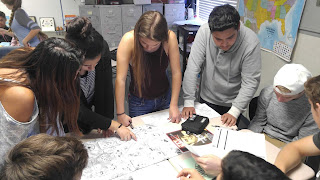In the craziness of COVID, I stopped blogging. But now I am back, inspired by colleagues sharing their teaching experiences. So let's recap the last few years of my journey to becoming a whole new kind of teacher.
Once we returned to in person learning, I was so disillusioned with the way students were responding, both academically and behaviorally, that I knew I needed to big change. That school year of 21-22 was definitely one of my worst in 22 years of teaching! I had students who refused to collaborate, or even talk to others at their table, students who threw food in class (11th grade boys), and just too many not caring about their grades. By the end of the year, even colleagues were snapping at each other. Many teachers I knew were not in a good place.
That August, I returned with a renewed sense of purpose and a new focus for how I would teach. I decided to stop teaching my 11th grade US History class chronologically, and instead focus on themes. It was the best decision I could have made! Not only was I re-energized, but my students overwhelming responded that they preferred the new method. In fact, the 22-23 school year was definitely one of my BEST ever! I will address the themes in another post.
It was not jus the change to thematic teaching that made it so amazing, but the introduction of Edu Protocols. It started with a conversation with a former principal, who now works at the district office as an Assistant Superintendent. I was telling her about my struggles with student apathy and behavior. She gave me the first of the Edu Protocols books to read, The Edu Protocol Field Guide. I took it home and was in her office a week later begging for more. By the time I had gone back to school, I head read the Edu Protocol Field Guide Book 2, Deploying Edu Protocols: A Guide to Educational Change Leaders, and the Edu Protocol Field Guide Social Studies Edition. I was obsessed and ready to transform my classroom!
For those not familiar with Edu Protocols, they are lesson frames that can be used with any content and any grade level K-college. The premise is that once students learn the structure of a lesson or activity, that they can then get into more complex content and with deeper thinking than before. I use many of them in my classroom now and will continue to share lessons that I do to show how to implement them. My school has also taken on the task of rolling out Edu Protocols schoolwide over the course of multiple years.
The 23-24 school year was another one of my favorites. I continued to improve thematic teaching and rolling out Edu Protocols. Now in 25-26, I decided to make a switch to teach Government. My degree is in political science and I wanted a new challenge. I had taught US History for most of my 25 year career. I will still continue to teach US History through my AP class, but am very excited to get to apply Edu Protocols to the study of American Government.
I am excited to be back writing again and hope that the strategies and struggles I share will help inspire and improve other teacher's classrooms as well.





